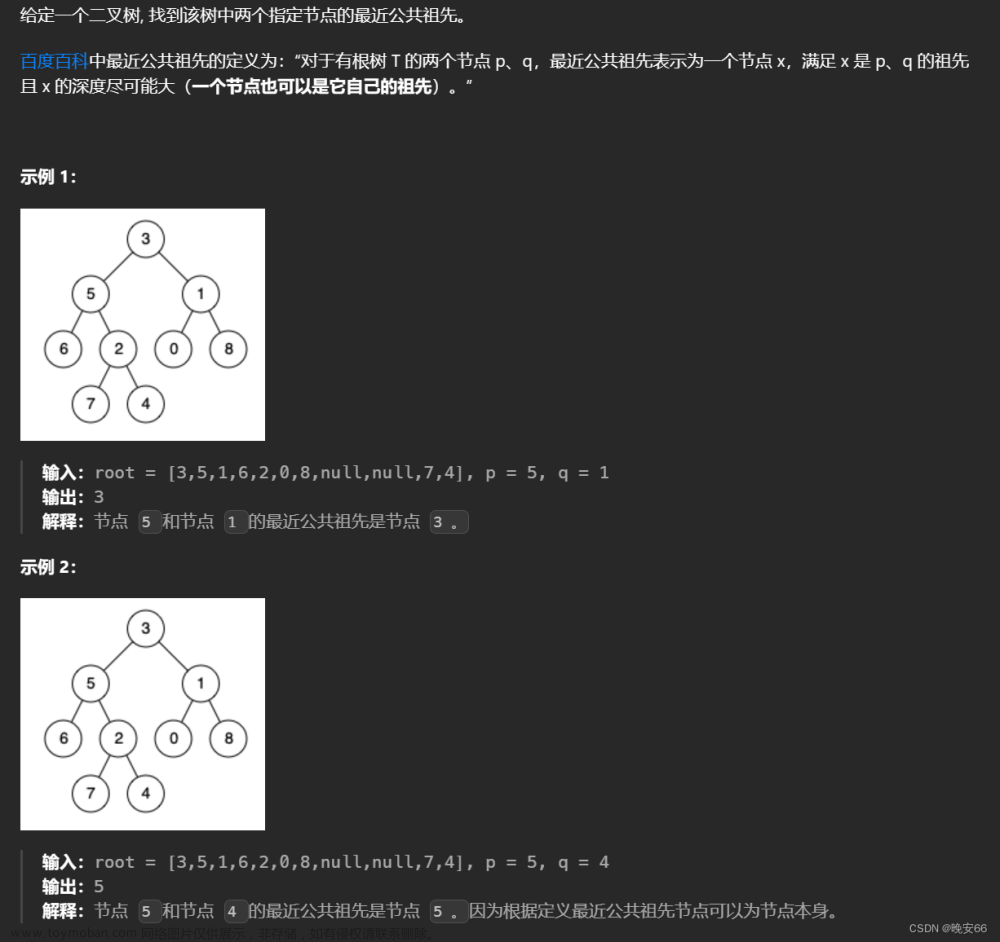leetcode 题目
236. 二叉树的最近公共祖先
参考:最近公共祖先
思路
f
a
[
i
]
[
j
]
\rm{fa}[i][j]
fa[i][j] 表示结点
i
i
i的第
2
i
2^i
2i个组先
d
e
p
[
i
]
\rm{dep}[i]
dep[i] 表示结点
i
i
i的深度
n
e
x
t
[
i
]
[
0
]
\rm{next}[i][0]
next[i][0] 表示结点
i
i
i的左子结点
n
e
x
t
[
i
]
[
1
]
\rm{next}[i][1]
next[i][1] 表示结点
i
i
i的右子结点
特别地,
- i = 0 表示一个不存在的结点
- i = 1 表示树的根结点
- fa[i][0] 表示结点i的父节点
首先,通过树的深度优先遍历,计算fa和dep数组。
假定要求x和y两个结点的最近公共祖先,那么通过fa快速把x,y调整到一样的高度。然后分两种情况:文章来源:https://www.toymoban.com/news/detail-653418.html
- 如果此时x = y, 则已经找到最近公共祖先
- 否则,通过fa找到最近公共祖先之下,第一个不是它们祖先的点。它们的父节点即是最近公共祖先。
复杂度分析
假设有n个结点
预处理:每个节点至多有
log
n
\log n
logn个父节点,因此时间复杂度为
T
(
n
)
=
O
(
n
⋅
log
n
)
T(n) = O(n \cdot \log n)
T(n)=O(n⋅logn)
查找:从上到下调平以从下到上找第一个共公祖先,最多
O
(
log
n
)
O(\log n)
O(logn)次,因此时间复杂度为
T
(
n
)
=
O
(
log
n
)
T(n)=O(\log n)
T(n)=O(logn)。文章来源地址https://www.toymoban.com/news/detail-653418.html
代码
/**
* Definition for a binary tree node.
* public class TreeNode {
* int val;
* TreeNode left;
* TreeNode right;
* TreeNode(int x) { val = x; }
* }
*/
class Solution {
int[][] fa;
int[] dep;
int[][] next;
public void dfs(int node, int p){
if(node != 0){
fa[node][0] = p;
dep[node] = dep[p] + 1;
for(int i = 1; i < 31; i++){
fa[node][i] = fa[fa[node][i-1]][i-1];
}
dfs(next[node][0], node);
dfs(next[node][1], node);
}
}
public int lca(int x, int y){
if(dep[x] > dep[y]) {
int t = x; x = y; y = t;
}
int tmp = dep[y] - dep[x];
int weight = 0;
// 从下往上把两者高度调成一样
while(tmp > 0){
if((tmp & 1) == 1){
y = fa[y][weight];
}
tmp >>= 1;
weight ++;
}
// 如果相等,则已经找到答案
if(x == y) return x;
// 从上往下找到第一个非公共的
for(int i = 30; i >= 0 && x != y; i--){
if(fa[x][i] != fa[y][i]){
x = fa[x][i];
y = fa[y][i];
}
}
return fa[x][0];
}
HashMap<TreeNode, Integer> map = new HashMap<>();
ArrayList<TreeNode> arr = new ArrayList<>();
int index = 0;
public void proceed(TreeNode root){
if(root != null){
map.put(root, ++index);
arr.add(root);
proceed(root.left);
proceed(root.right);
}
}
public void proceed2(TreeNode root){
if(root != null){
next[map.get(root)][0] = map.get(root.left);
next[map.get(root)][1] = map.get(root.right);
proceed2(root.left);
proceed2(root.right);
}
}
public TreeNode lowestCommonAncestor(TreeNode root, TreeNode p, TreeNode q) {
map.put(null, 0);
arr.add(null);
proceed(root);
fa = new int[arr.size()][31];
dep = new int[arr.size()];
next = new int[arr.size()][2];
proceed2(root);
dfs(1, 0);
return arr.get(lca(map.get(p), map.get(q)));
}
}
到了这里,关于更快的求最近公共祖先(LCA)的算法-倍增法求LCA的文章就介绍完了。如果您还想了解更多内容,请在右上角搜索TOY模板网以前的文章或继续浏览下面的相关文章,希望大家以后多多支持TOY模板网!









